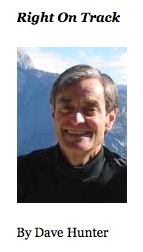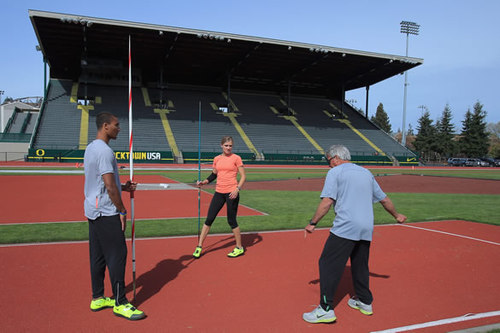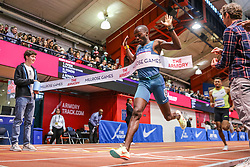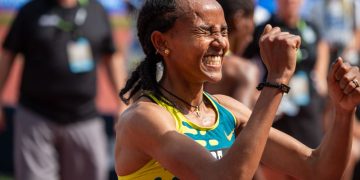I was hoping to join our team for the NCAA outdoor, but I got sick a week ago. Runblogrun.com is fortunate to have David Hunter, Ryan Stevenson and Kevin Mangan covering the meet for us. This is David Hunter’s opening piece on the NCAA!
2013 NCAA Div I Outdoor Track & Field Championships
Anticipation Builds For NCAA Crescendo
Sparkling Individual Duals To Highlight Chase For Team Titles
June 5, 2013
Eugene, Oregon
After a collegiate season full of dual meets, storied relays, high-profile invitationals, and conference championships, the long-awaited Division I NCAA outdoor track & field championship meet is finally here. All of the past times, marks, and distances count for little now. You have to go out and make it happen over the next four days at iconic Hayward Field. Go hard or go home.
The battles for both the women’s and men’s team titles shape up to be tight and highly competitive.
On the women’s side, the aficionados give a slight edge to Kansas over host Oregon. The Jayhawks – featuring their crown jewel sprinter Diamond Dixon who will run the 400 and both relays – look to complement their track strength with talented field athletes led by the potent horizontal jump duo of Andrea Geubele and Sydney Conley. The Lady Ducks – gunning to  complete a yet-unaccomplished national team title “Triple Crown” – are counting on a broad base of scoring. To prevail, Oregon will need to harvest significant points from its deep middle distance corps of Laura Roesler, Annie LeBlanc, Anne Kesselring, and Becca Friday.
complete a yet-unaccomplished national team title “Triple Crown” – are counting on a broad base of scoring. To prevail, Oregon will need to harvest significant points from its deep middle distance corps of Laura Roesler, Annie LeBlanc, Anne Kesselring, and Becca Friday.
For the men, Florida and Texas A&M are expected to wrestle for the crown. The Gainesville contingent – led by hurdle star Eddie Lovett [13.53w] – will be counting on a point spurt from its deep sprint squad and – of course – its premier triple jumpers, Omar Craddock [52′ 7½”] and Marquis Dendy [51’9½”]. The squad from College Station is expecting good scoring from its impressive sprinters: the trio of Ameer Webb, Prezel Hardy and Michael Bryan – each of whom made it through in both sprints; 400 behemoth Deon Lendore; and collegiate 110H leader Wayne Davis [13.27w]. In a sport where hundredths of seconds and centimeters mean valuable points, you can be sure that Pat Henry – the Texas A&M head coach – is seeking to cultivate the psychological edge by reminding his charges that it was the Gators who last year ended the Aggies three-year reign. If the team title comes down to the 4 x 400 – as is often the dramatic scenario here – the smart money will be on Texas A&M – with Big Dog Lendore on the anchor for the Aggies.
In addition to the quest for the team trophy, the NCAA championship meet always showcases great individual competition – some long-anticipated, some unexpected. Two showdowns in particular will be well worth watching carefully.
In the women’s 5000 final, look for Dartmouth junior Abbey D’Agostino to compete fiercely with Oregon senior and hometown favorite Jordan Hasay. Will D’Agostino – 5th in last year’s Oly Trials 5000 here in Eugene – deny Hasay her final opportunity to capture an individual NCAA outdoor title? Or – as has happened so many times in the past – will that Hayward Field magic prove to be just the home court advantage Hasay needs to finally capture her first individual outdoor national crown?
It is rare for reigning Olympic medalists to do battle in the NCAA championship meet. But In the men’s high jump, Kansas State’s Erik Kynard – the Olympic silver medalist – will square off against Indiana’s Derek Drouin – London’s bronze medalist. The two jumpers made it easily through Regionals with gimme qualifying clearances: Drouin sailing over 7′ 1½” [2.17m] and Kynard jumping 7’½” [2.16m]. But it will be “Game On” this weekend as the vertical leapers are coming off stunning P.R. performances at last weekend’s Prefontaine Classic where they both cleared 2.36m [7’8 ¾”]. With his stylish white and purple knee socks, the Wildcat high jump star they call Little Kobe will be need to bring his “A” game to defend his NCAA crown against the Hoosier’s Canadian Olympian. These two Olympic podium performers ought to put on quite an intense and entertaining show for the knowledgeable Hayward Field crowd.
And so the stage is set for 4 days of top flight competition – with many far too certain about how it will all unfold. To be sure, a careful examination of the pre-race form sheets offers important insights about the meet yet to begin. But that review can promote a false sense of predictability about a season-ending meet that rarely runs true to form. The electricity of the NCAA championships comes not from events playing out as predicted. It comes from the inevitable unexpected and outstanding performances and the unanticipated upsets. That’s why they run the meet.
~Dave Hunter






















